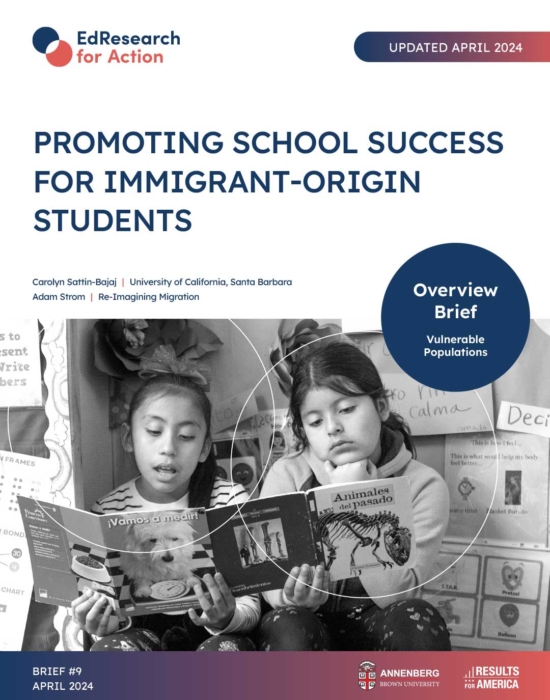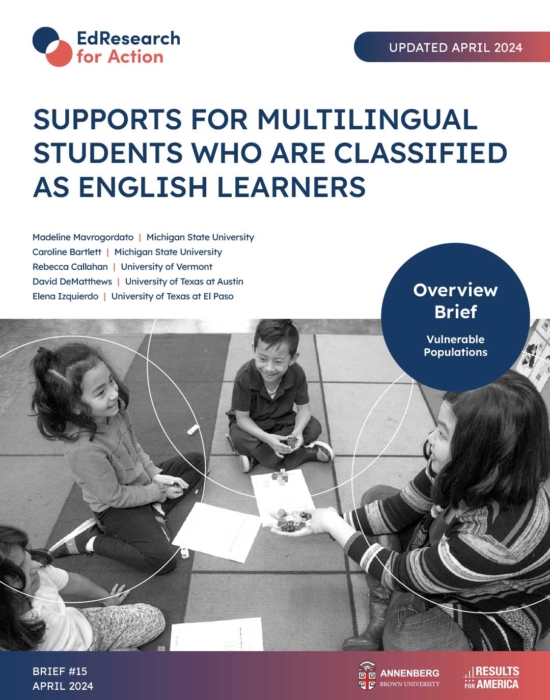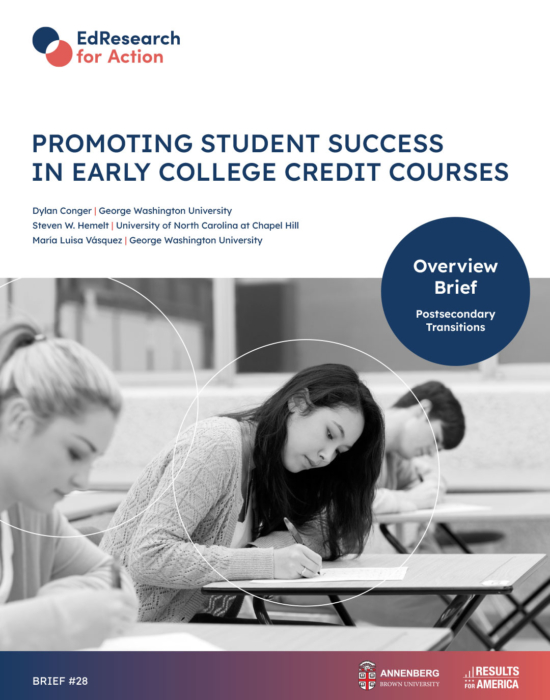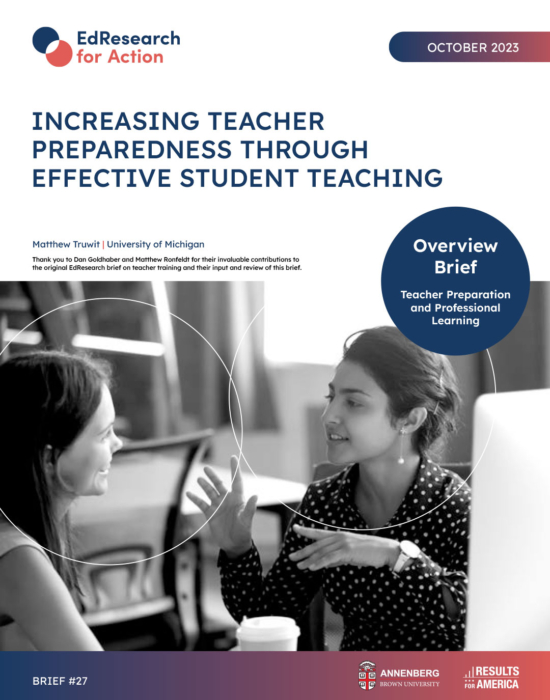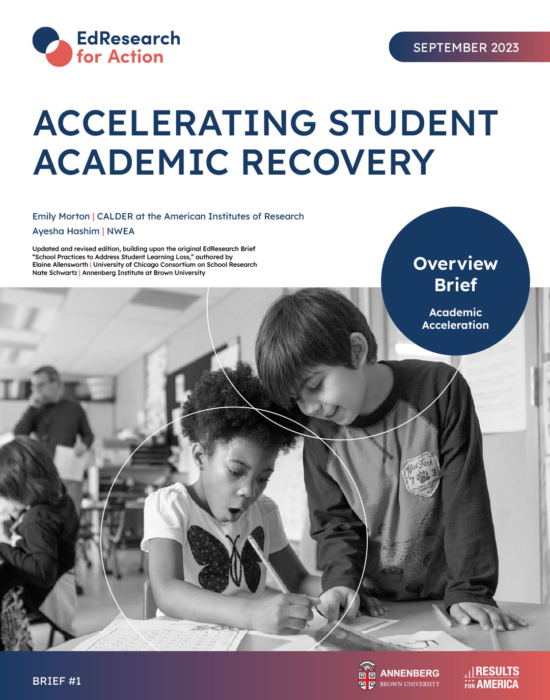PROMOTING SCHOOL SUCCESS FOR IMMIGRANT-ORIGIN STUDENTS
The EdResearch for Action Overview Series summarizes the research on key topics to provide K-12 education decision makers and advocates with an evidence base to ground discussions about how to best serve students. Authors – leading experts from across the field of education research – are charged with highlighting key findings from research that provide concrete, strategic insight on persistent challenges sourced from district and state leaders.
Carolyn Sattin-Bajaj | University of California, Santa Barbara
Adam Strom | Re-Imagining Migration
April 2024 | Brief No. 9
Central Question
How can schools and districts promote the educational and social-emotional well-being of the diverse population of immigrant-origin students?
Note: There is considerable overlap between the immigrant-origin population and the English Learner (EL) population. This brief focuses on the former, and another EdResearch brief focuses on research-based practices for English Learners.
Key Insights
Breaking Down the Issue
- Immigrant-origin students’ performance in K-12 education has varied over time, with periods of both lower and higher performance compared to native-born peers.
- Differences in achievement between immigrant-origin and native-born students primarily result from variations in family and school resources, and this is compounded by issues like interrupted schooling and language barriers.
- Immigrant-origin students may experience stressors related to immigration status and immigration enforcement threats that can affect their academic performance and overall well-being.
Evidence-Based Practices
- Accessible communications in multiple languages and formats can bolster home-school connections and improve student engagement.
- Programs aimed at engaging immigrant-origin families can foster collaboration, cultural understanding, and educational success within the school community.
- Embracing cultural diversity in schools encourages increased engagement and promotes cross-cultural learning.
- Formal programs and after-school supports have been shown to improve academic performance for immigrant youth.
- Schools that offer information and support related to immigrants’ legal and educational rights can enhance immigrant-origin students’ engagement and success.
- Strong teacher-student relationships can contribute to students’ school persistence, sense of belonging, and educational aspirations.
- To foster immigrant-origin students’ sense of belonging and civic identity, educators must be prepared to confront anti-immigrant hostility and address student trauma.
Practices to Avoid
- Separating immigrant students from their non-immigrant peers in classes or schools can have adverse effects on all students.
- When immigrant students are denied access to rigorous coursework and diverse elective options, it can hinder their academic progress and social integration.
Breaking Down the Issue
What do we know about the population of immigrant-origin students in the U.S. today?
Immigrant-origin children are the fastest-growing segment of the country’s school-age population. As of 2021, around 25% of school-age children had at least one foreign-born parent, a remarkable surge from 13% in 1990 and 19% in 2000. However, this demographic transformation is far from monolithic. Among K-12 immigrant-origin students, almost 90% are second-generation, U.S.-born children of immigrants, while the remaining 10% are first-generation immigrants. Approximately half of this population identifies as Latino/a. In 2019, about 7% of U.S. children lived with undocumented parents, with nearly 13% of them sharing the same undocumented status.
Over 1 million immigrants come to the U.S. annually. The largest number of immigrants comes from Mexico, accounting for 24% of the total immigrant population in 2021. Since 2009, however, Asian immigrants to the U.S. (largely from China and India) have outpaced all other groups; this is partly due to slowed immigration from Latin America, especially from Mexico, during and after the Great Recession. While traditional immigrant destinations like California, Texas, New York, and Florida continue to have the largest numbers of children with immigrant parents, new destinations such as North Dakota and Montana have experienced significant growth in the immigrant-origin student population.
Immigrants to the U.S. represent the full distribution of education and income levels. While immigrants were over three times more likely to have not completed high school than U.S.-born residents (27% vs. 8%), immigrants were equally as likely as U.S.-born adults to have earned a bachelor’s degree or higher (~33%). Despite the diverse backgrounds of immigrants, immigrant-origin children are more likely to experience poverty compared to their peers with native-born parents. As of 2021, children of immigrants accounted for 31 percent of the 25 million children living under the poverty line. Furthermore, 43 percent of immigrant-origin students were in families classified as “low-income” compared to 34 percent of children without immigrant parents. These circumstances have implications for their educational access and opportunities, particularly regarding technological resources and online learning.
Which existing federal and state laws, policies, and court rules shape immigrant-origin students’ educational access and opportunities?
Federal legislation, Supreme Court rulings, and executive actions significantly impact the educational access and opportunities of immigrant-origin students. A pivotal milestone was the 1982 Plyler vs. Doe Supreme Court decision, which firmly established that all children, regardless of immigration status, have the right to a free public education. Schools, like churches and hospitals, are considered “protected areas” where Immigration and Customs Enforcement (ICE) cannot intervene.
Much of the legislation and funding for immigrant-origin students focuses on language acquisition. Title VI of the 1964 Civil Rights Act, for instance, mandates free interpretation and translation services, thereby ensuring that multilingual students and their parents can effectively engage with the educational system. Further bolstering these efforts is Title III of the Elementary and Secondary Education Act (ESSA), which provides funding for language instruction, teacher training, resources, curriculum, and, to a somewhat lesser extent, activities designed to fortify parent, family, and community involvement. Complementing these initiatives is the Migrant Education Program, under ESSA’s Title I, which supports the education of children of migrant agricultural workers.
Deferred Action for Childhood Arrivals (DACA), established in 2012, protects young adults brought to the U.S. as children from deportation and grants them temporary work permits and permission to remain in the U.S. for educational pursuits. As of 2022, there were roughly 580,000 active DACA recipients from nearly 200 different countries of origin. While the Biden Administration supports DACA and existing authorizations remain in effect, approval for new DACA applications is currently on hold due to legal challenges stemming from the Trump Administration’s rescission of the program.
How do immigrant-origin students perform in K-12 education, and what challenges do they face?
Immigrant-origin students’ performance in K-12 education has varied over time, with periods of both lower and higher performance compared to native-born peers.
- This variability is largely driven by factors such as parental education, income, socio-economic status in home countries, country of origin, and school setting.
- Students from Asian and African countries, who tend to come from higher socio-economic backgrounds, often outperform native peers, while those of Latin American descent are more likely to have parents with lower levels of education and income, attend under-resourced schools, and have lower achievement levels.
Differences in achievement between immigrant-origin and native-born students primarily result from variations in family and school resources, and this is compounded by issues like interrupted schooling and language barriers.
- First-generation immigrant students tend to attend high-poverty schools with fewer resources and lower average education outcomes compared to their non-immigrant peers.
- In addition, interrupted schooling, language barriers, and the transition to a new cultural context can complicate the accurate placement of immigrant students into appropriate grade levels and courses and result in missed- or misdiagnoses and restricted opportunities for advanced course-taking.
Immigrant-origin students may experience stressors related to immigration status and immigration enforcement threats that can affect their academic performance and overall well-being.
- Children of undocumented parents tend to perform lower on standardized tests, experience mental health and behavioral issues, and have lower post-secondary aspirations. Moreover, attending schools in areas with frequent immigration enforcement activity is linked to chronic absenteeism, lower academic achievement, reduced enrollment, and worsened school climate ratings, especially among Latine students and English learners.
- Children of immigrant parents are frequently asked to serve as interpreters for adult family members due to inadequate translation services, complicating family dynamics. Additionally, immigrant-origin children might experience migration-related trauma, affecting mental health, academic engagement, and behavior. Lastly, forces like parental immigration stress, transnational ties, cultural context, and racial/ethnic segregation shape identity development, which, in turn, influences academic engagement, performance, and overall well-being.
Evidence-based Practices
Which district-, school- and classroom-level policies and practices can promote healthy development, achievement, and well-being among immigrant-origin students?
Accessible communications in multiple languages and formats can bolster home-school connections and improve student engagement.
- School districts are legally mandated to ensure that education-related information is accessible to all families. Larger districts often have interpretation hotlines and trained staff for this purpose, while smaller ones can partner with local organizations to enhance translation capabilities.
- While translation apps can be useful in emergencies, they are not recommended as a primary solution. Talking Points, an app facilitating multilingual communication, allows districts and teachers to connect with families without requiring app downloads, ensuring individual and mass messages while safeguarding privacy.
Programs aimed at engaging immigrant-origin families can foster collaboration, cultural understanding, and educational success within the school community.
- District and school-level efforts to engage in collaborative decision-making help immigrant parents become more effective advocates for their children. A case study involving a Mexican immigrant parent empowerment initiative in a California district found that involving immigrant families in agenda-setting and resource allocation boosted parental engagement, fostering a stronger sense of belonging and active involvement. Activities like parent-selected workshops equipped immigrant parents with the tools to support their children’s educational success.
- Collaboration between districts, schools, and community leaders can help expand immigrant-origin caregivers’ engagement with schools and in their children’s learning. In a successful pilot program, Fairfax Public Schools and the Smithsonian Learning Lab and researchers at Harvard Project Zero-Re-Imagining Migration facilitated conversations to enhance family bonds, cultural pride, and understanding.
- Programs like the Immigrant Parent Leadership Initiative at Annandale High School provided targeted support for and developed partnerships with immigrant parents. Districts can provide similar support by partnering with community-based organizations, including faith-based, immigrant-serving, health, and advocacy organizations, that have already established relational trust with immigrant families.
Embracing cultural diversity in schools encourages increased engagement and promotes cross-cultural learning.
- Promoting students’ multilingualism and encouraging them to use their home language(s) in schools can positively impact student engagement, relationships with teachers and classmates, and sense of belonging.
- Culturally relevant learning opportunities are essential for sustained engagement and are associated with higher achievement. For example, teaching about immigrant-origin students’ histories and cultures, including their families’ stories of immigration across subjects (e.g., art, geography, history, literature, math, and science), offers an avenue to build connections and practice culturally responsive pedagogies. The benefits of exposure to such approaches extend to all members of the classroom community.
- By infusing school routines and daily “schooltalk” with messages of inclusivity, schools can create an environment where diversity is celebrated.
- Engaging in socio-politically relevant pedagogy has been shown to raise students’ critical thinking and global awareness. Providing resources and support to educators for facilitating constructive discussions about controversial issues in classrooms allows them to create an environment where all students have opportunities to engage in informed and respectful dialogue about controversial topics.
- Teachers should be given time and support in planning for instruction that integrates language learning into core curriculum to support the academic and social growth of students.
Formal programs and after-school supports have been shown to improve academic performance for immigrant youth.
- One study of high school-age newcomer immigrant students found that attending homework help sessions at school was a key contributor to homework completion.
- School districts can partner with community-based organizations, public libraries, and municipal offices to offer a range of educational resources. Libraries in places like Glendale, California, offer live online support, including homework aid, writing assistance, practice tests, and college counseling, catering to both students and adults seeking various forms of educational assistance.
Schools that offer information and support related to immigrants’ legal and educational rights can enhance immigrant-origin students’ engagement and success.
- School districts can demonstrate their commitment to the inclusion and support of undocumented students and families through clear policies that protect the educational rights of undocumented students and training that empowers and supports staff to become allies and advocates for immigrant-origin students. As well as widespread messages, legal services, and information and by removing barriers to access and enrollment. Initiatives such as Boston Public School’s “We Dream Together” website and Minneapolis Board of Education’s public resolution showcase this commitment.
- Providing educators with training on immigrants’ rights and sharing resources like Learning for Justice’s Guide for Educators or Know Your Rights materials can empower them to address students’ concerns and fears, fostering a sense of security.
- Teachers and school support staff who encourage undocumented students’ aspirations and establish themselves as sources of guidance play a pivotal role in positively shaping students’ academic and personal trajectories.
Strong teacher-student relationships can contribute to students’ school persistence, sense of belonging, and educational aspirations.
- School policies, practices, and training for staff that demonstrate recognition of the ways that immigration can impact students’ and families’ lives can be powerful for young people, contributing to their school persistence, sense of belonging, and educational aspirations.
- Educators can take advantage of informal opportunities to develop connections with and among students. Encouraging students to share their migration stories with their classmates not only deepens connections but also diminishes bias, empowers immigrant-origin students, and cultivates empathy among their peers. “Moving Stories” resources from Re-Imagining Migration offer a framework for incorporating storytelling units into virtual classrooms.
To foster immigrant-origin students’ sense of belonging and civic identity, educators must be prepared to confront anti-immigrant hostility and address student trauma.
- School leaders and teachers who are knowledgeable about immigrants’ rights are well-positioned to challenge negative narratives, fostering safe learning environments.
- School personnel must be prepared and empowered to combat discriminatory language and behavior, including online bullying.
- Experts in youth trauma recommend employing trauma-informed approaches to support students who may have experienced trauma before or after immigrating. Trauma screening and evidence-based care are vital components to enhance the quality of education and care for immigrant-origin youth.
Newcomer students may benefit from specific policies and practices designed with their particular needs and experiences in mind.
- Clear welcome messages and procedures for newcomer enrollment and integration, such as those found in the Internationals Network Newcomer Welcome Kit, can provide an important foundation for a successful school start
- School personnel should be trained to collect and understand information about newcomers’ prior educational experiences in order to identify and build on their knowledge and skills.
- Involving families in the intake process and in ongoing ways throughout the school year helps strengthen home-school connections, provide insight into newcomer students and their experiences, foster community, and improve newcomer student outcomes.
- Beyond the intake process, teachers should be given time and support in planning for instruction that integrates language learning into the core curriculum to support the academic and social growth of students.
Practices to Avoid
What strategies have been ineffective?
Separating immigrant students from their non-immigrant peers in classes or schools can have adverse effects on all students.
- When students from diverse linguistic, racial/ethnic, and nativity backgrounds are separated in classes or schools, it can negatively impact their social and civic integration. This practice also extends to early tracking of English learners and grade retention for immigrant students, which can harm graduation rates and hinder integration.
- A 2021 study revealed that U.S.-born students who have greater exposure to immigrants achieve higher scores in both math and reading tests than similar students with low exposure to immigrants. This positive effect of exposure applies to both higher- and lower-achieving students.
When immigrant students are denied access to rigorous coursework and diverse elective options, it can hinder their academic progress and social integration.
- In an effort to fast-track students’ English language acquisition, emergent multilingual students might be removed from class or limited in accessing advanced courses, which can hinder their overall academic development and their eligibility for college admissions. Further, such restrictions could lead to disengagement. While language support is crucial, it should not compromise students’ access to grade-level academic content.
- Failure to engage in open discussions about migration could also harm students’ civic development and civic efficacy and understanding.

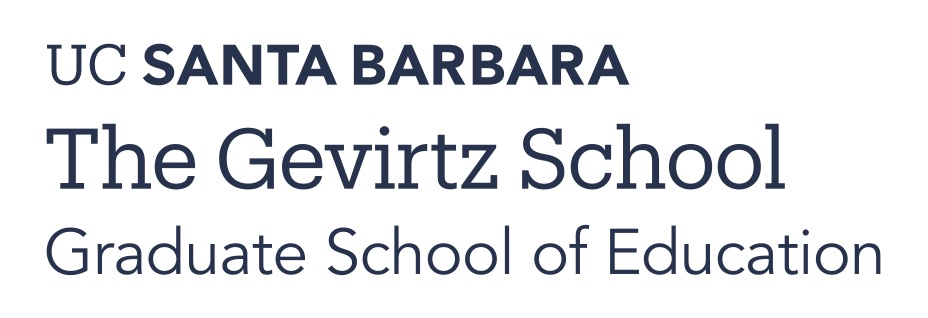
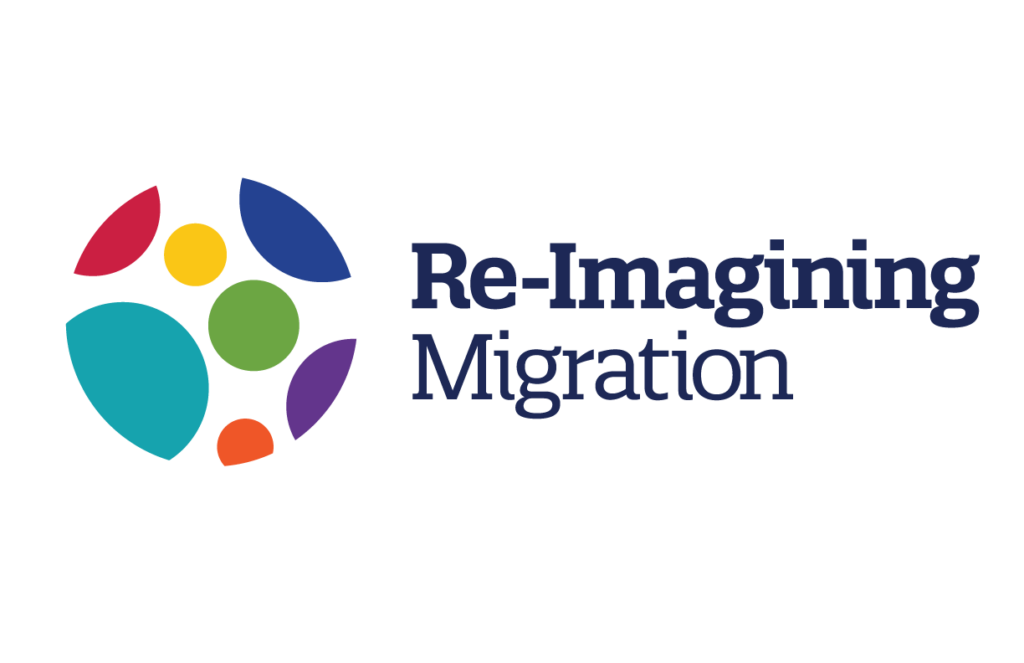
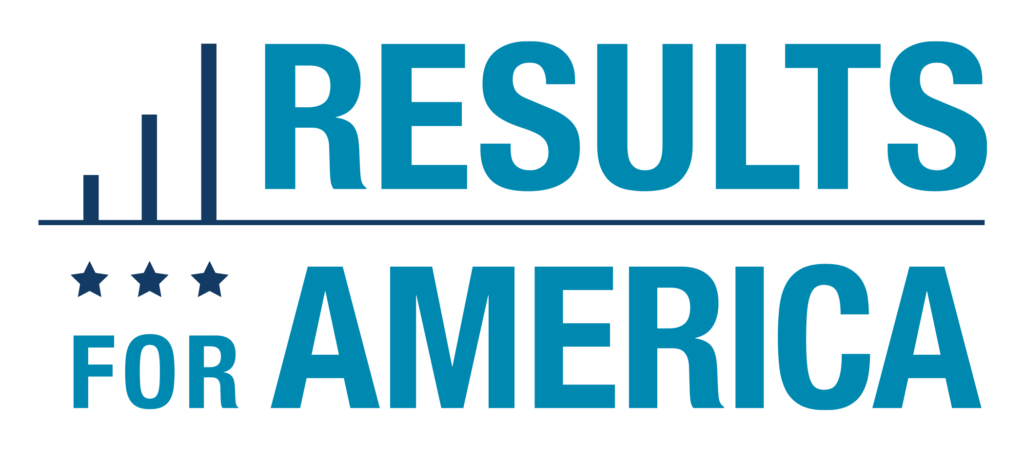
Funding for this research was provided by the Bill & Melinda Gates Foundation. The findings and conclusions contained within are those of the authors and do not necessarily reflect positions or policies of the foundation.

